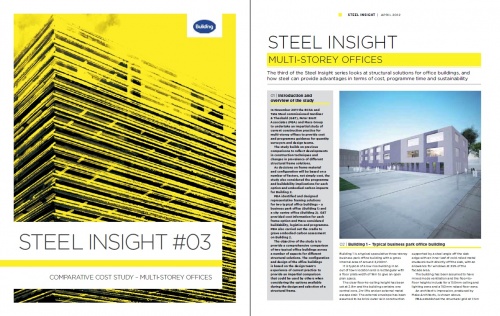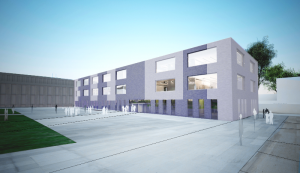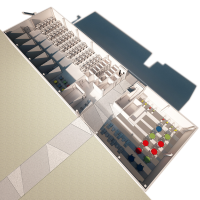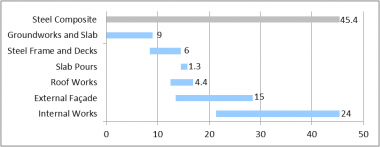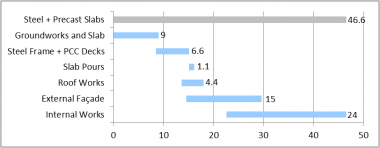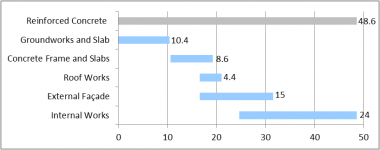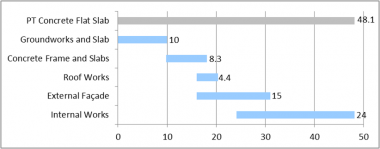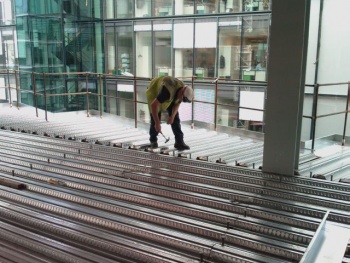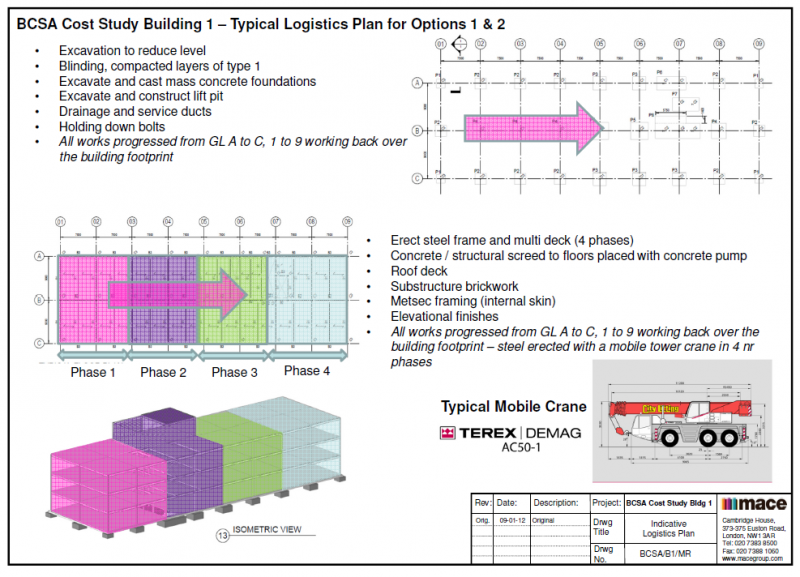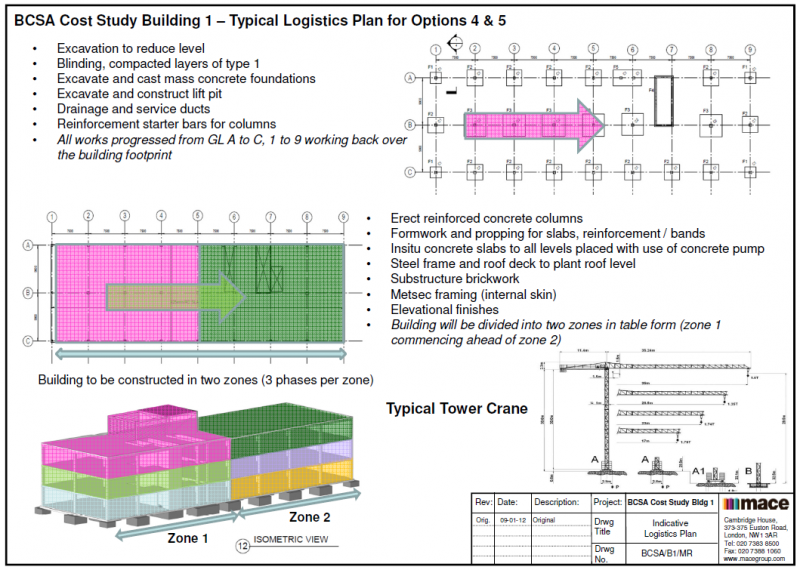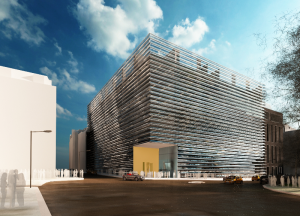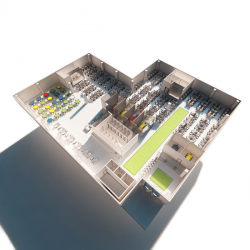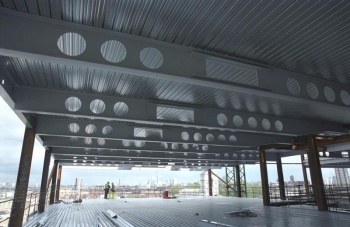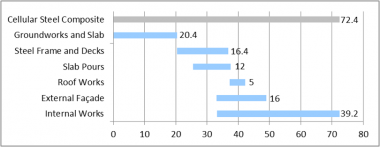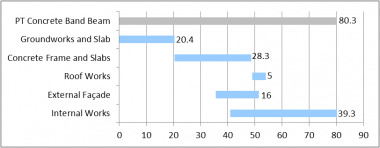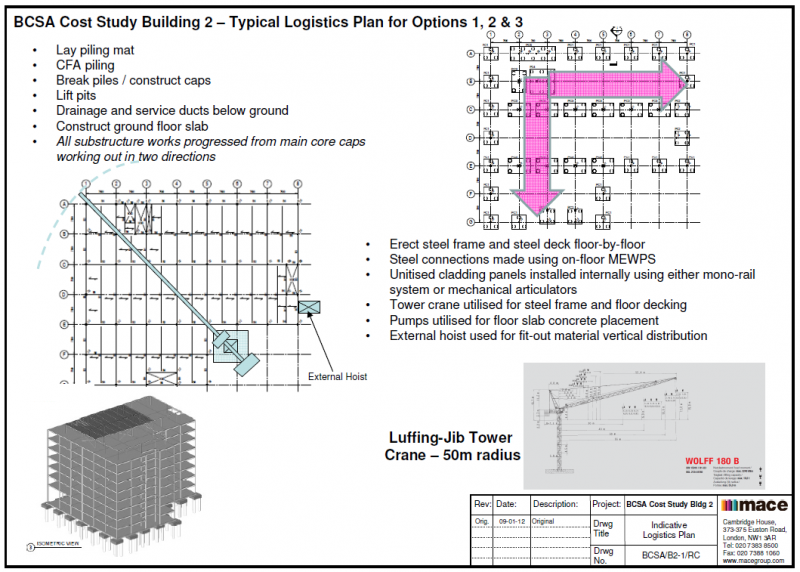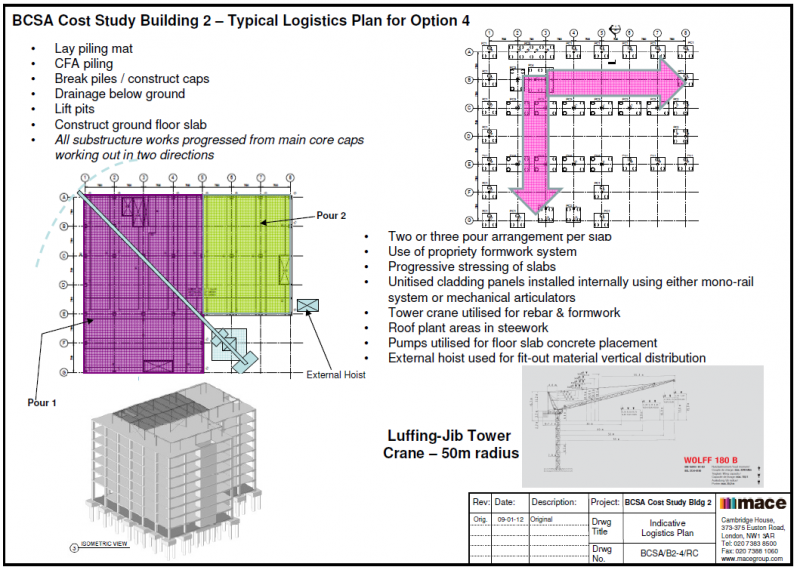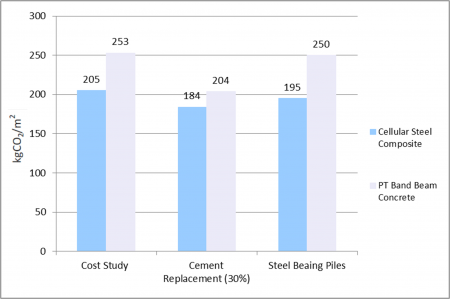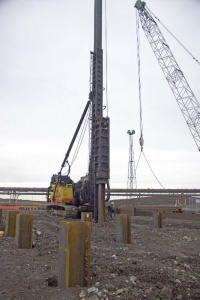Cost comparison study
In November 2011, the British Constructional Steelwork Association (BCSA) and Tata Steel commissioned Gardiner & Theobald (G&T), Peter Brett Associates (PBA) and Mace Group to undertake an impartial study of current construction practice for multi-storey office construction to provide cost and programme guidance for Quantity Surveyors and design teams. The study builds on previous comparisons to reflect developments in construction techniques and changes in prevalence of different structural frame solutions.
As decisions on frame material and configuration will be based on a number of factors, not simply cost, the study also considered the programme and buildability implications for each option. PBA identified and designed representative framing solutions for two typical office buildings:
- Building 1 - A business park office
- Building 2 - A city centre office
G&T provided cost information for each frame option and Mace considered buildability, logistics and programme. PBA also carried out a cradle to cradle embodied carbon assessment on Building 2. The costs were regularly updated by G&T through to October 2016 to keep the study up-to-date and relevant.
The objective of the study was to provide a comprehensive comparison of two typical multi-storey office buildings across a number of aspects for different structural solutions. The configuration and design of the buildings was based on the design team’s experience of current practice to provide an impartial comparison that could be used by others when considering the options available during the design and selection of a structural frame.
[top]Building 1 - Typical business park office building
Building 1 is a typical speculative 3 storey business park office building with a gross internal area of around 3,200m². It is typical of a low rise building in an out of town location and is rectangular, with a floor plate width of 18m to give an open plan space.
The clear floor-to-ceiling height has been set at 2.8m and the building contains one central core, two lifts and an external metal escape stair. The building envelope has been assumed to be brick outer skin construction supported by a steel angle off the slab edge with an inner leaf of cold rolled metal studwork built directly off the slab, with an allowance for windows at 35% of the façade area. The building has been assumed to have mixed mode ventilation and the floor-to-floor heights include for a 150mm ceiling and lighting zone and a 150mm raised floor zone.
An architect’s impression and indicative cutaway, produced by Make Architects, are shown.
PBA established the structural grid at 7.5m x 9m based on an optimum grid for a typical business park office not dictated by site constraints and this was used for all frame types, which consisted of the following four options:
- Steel composite beams and composite slab
- Steel frame and precast concrete slabs
- Reinforced concrete flat slab
- In situ concrete frame with post tensioned slab
For all options the foundations have been designed as unreinforced mass concrete pads, the core construction is steelwork cross braced framing with a medium density blockwork infill for the steel options and concrete shear walls for the concrete options.
For both steel options, the 30 minute fire resistance is provided through thin film intumescent coating to beams and bracing members and boarding to columns, while for the concrete options, it is assumed that the internal columns are plastered and painted for aesthetic purposes.
Allowances have been made for all options for a part open and part enclosed roof plant area and lift motor room. In terms of roof construction, the two steel framed options have a lightweight steel deck roof, while the concrete options continue the concrete slab construction of the lower floors.
The floor-to-floor heights for the steel framed options include an 800mm service zone below the metal deck (300mm clear beneath the beams) and the concrete options allow for a 600mm services zone beneath the slab.
[top]Cost comparison (B1)
Gardiner & Theobald LLP provided the costs for the study, based on market testing and recently tendered projects. Costs are all at Q3 2016 prices, exclude fees, VAT, project contingency and furniture, fixtures and equipment/AV allowances etc. and are based on construction in Central London to enable direct comparison with Building 2.
The study recognises the importance of considering all elements of the total building cost, not simply the cost of the structure as some elements are affected more by the choice of structural frame than others. As such, the study considered whole building cost rather than just structural frame cost. The substructure, roof and external cladding costs were assessed for each option rather than including constants across all options.
| Central London costs | Steel Composite | Steel + Precast Concrete Slabs | Reinforced Concrete Flat Slab | Post Tensioned Concrete Flat Slab |
|---|---|---|---|---|
| Substructure | £71 /m2 GIFA | £75 /m2 GIFA | £91 /m2 GIFA | £85 /m2 GIFA |
| Frame and Upper Floors | £177 /m2 GIFA | £196 /m2 GIFA | £173 /m2 GIFA | £205 /m2 GIFA |
| Total Building | £1,982 /m2 GIFA | £2,099/m2 GIFA | £2,183 /m2 GIFA | £2,165 /m2 GIFA |
The above costs can be adjusted for different locations using BCIS location factors.
| Location | BCIS Index | Location | BCIS Index |
|---|---|---|---|
| Central London | 124 | Leeds | 92 |
| Nottingham | 93 | Newcastle | 95 |
| Birmingham | 99 | Glasgow | 96 |
| Manchester | 101 | Belfast | 62 |
| Liverpool | 96 | Cardiff | 92 |
The impact of the construction programme for each option has been considered in the total building costs, with the steel options benefitting from lower preliminaries costs due to their shorter construction programmes (as reviewed in detail below).
The steel composite beams and slab option has the lowest total building cost. This option has the lowest substructure costs of all frame options due to the lighter frame weight and the lowest roof cost due to the lightweight steel roof deck. The structural zone and floor-to-floor height, while not the lowest of all the options, does not result in elevated cladding costs as only the concrete post tensioned flat slab option has a notably lower floor-to-floor height and therefore reduced area of cladding.
Conversely, the reinforced concrete flat slab option has the highest overall building cost, some 10% higher than the composite beam and slab alternative. This option has the highest substructure costs due to the heavier frame weight, the highest roof costs and the highest preliminaries costs due to the longest programme.
A review of the steel composite beams and slab and the reinforced concrete flat slab options also highlights the importance of considering total building cost rather than just frame and floor costs when analysing and selecting the structural frame material during the design stages. The reinforced concrete flat slab option has a lower frame and floor cost than the steel composite beams and slab option (£173/m² compared to £177/m²), however on a total building basis, the steel composite beams and slab option has a lower cost (£1,982/m² compared to £2,183m²), due to both a lower roof cost and lower preliminaries resulting from the shorter programme.
Therefore, on comparison of all four options, it is evident that on a like for like basis the steel composite beam and slab frame has the lowest overall building cost, followed by the steel and precast concrete floor slab option with the two concrete options being higher.
[top]Programme comparison (B1)
Cost is undoubtedly a key driver in decision making when comparing alternative frame materials and configurations. However for many projects, the comparative programme and buildability impacts are arguably as important and should also be considered when selecting the frame material.
Mace undertook the programming analysis for each option and to ensure a robust comparison, preceding and succeeding trades to the frame elements were included to ensure a holistic approach to the study.
The programme durations for construction of the ground floor slab (2 weeks 4 days), external façade (15 weeks) and internal works to a CAT A finish (18 weeks per floor) were assumed to be the same in overall duration for each option. The study assumes that the internal fit out commences on the ground floor and progresses up the building with a lag of 3 weeks between the commencement of the next floor, giving an overall duration of 24 weeks for each option.
The substructure duration was also considered in detail for each option. Both steel options required 9 weeks due to the similar quantity of work, however longer durations of 10 weeks 3 days for the reinforced concrete flat slab, and 10 weeks for the post tensioned option were required to reflect the higher volume of groundworks.
Building 1: Steel composite beams and slab frame programme
Building 1: Steel composite beams and precast concrete slab frame programme
The programmes for the frame and upper floor construction are similar for both steel options. The precast concrete floor slab requires slightly larger foundations than the composite beam and slab option, but this is largely offset by the reduced number of steel members in the the precast option, giving an overall very similar programme.
Similarly, it is quicker to lay the steel decking for the steel composite option due to the ability to load out multiple numbers of deck at any time while the precast planks are limited to one per lift, but this time advantage is offset due to the time required to stud weld each of the deck, which is a slower process than grout filling between the precast planks and both then require a concrete topping.
Ultimately, the advantages and disadvantages of each steel option largely cancel each other out providing very similar programme periods for both the frame and overall construction. The steel composite option however, due to the speed of laying and distributing the steel deck provides the quickest frame and overall duration by 1 week.
The programmes for the frame and upper floor construction are also similar for both concrete options as the processes involved in constructing the structure are fundamentally the same. The main variant is within the slab construction, with the post tensioned option providing a slightly quicker duration overall due to the lower quantity of reinforcement to place. The foundations duration for the post tensioned option is also quicker as the structure is lighter and therefore the extent of excavation and concrete pouring to the foundations is less.
Of all four options, the steel composite frame provides the fastest method of frame construction and overall programme for Building 1.
[top]Logistics and buildability (B1)
To inform the programmes, Mace undertook a logistics analysis for the frame options and this has been reflected in total building costs through the preliminaries analysis.
For both steel options, construction is assumed to be phased, with the excavation, foundations, drainage and service ducts, ground floor slab and erection of the steel frame and steel deck or precast planks occurring in four phases. A single mobile crane (about 50 tonnes) is used for material distribution and loading as full perimeter access to the building is available and the placing of concrete or structural screed to floors would utilise a concrete pump.
For both concrete options, construction is assumed to occur across two zones, each consisting of three phases. The sequence includes the excavation, concrete foundations, drainage and service ducts, ground floor slab, reinforced concrete columns, formwork and propping for slabs, reinforcement or post tensioned strands and placing of insitu concrete slabs using a concrete pump commencing in zone 1 ahead of zone 2. A tower crane located centrally on the building perimeter is assumed to be the most productive means of material distribution as they can be distributed between both construction zones. The cost of the tower crane base has been included in the preliminaries costs however it should be noted that there may be oversailing issues with a saddle jib crane.
[top]Building 2 - Typical city centre office building
Building 2 is a typical 8 storey speculative city centre office building with a gross internal area of around 16,500m². It is L-shaped with a double height reception area, central core and internal secondary escape stair. The clear floor-to-ceiling height has been set at 3.0m.
The building envelope is a unitised curtain wall system constructed in storey height panels 1.5m wide with feature fins/solar control. Solid areas are lined with cold rolled metal studwork, insulation and plasterboard. The building has been assumed to have four pipe fan coil air conditioning without natural ventilation.
An architect’s impression and indicative cutaway, produced by Make Architects, are shown.
PBA established the structural grid at 7.5m x 15m based on experience of similar city centre schemes, and this was used for both of the following frame options:
- Composite cellular beams and composite slab
- Post tensioned band beams and slab, in situ columns
Both options adopt CFA piles and there are typically 3-4 piles per column pile cap. The core construction is steel cross braced framing with a medium density blockwork infill for the steel option and concrete shear walls for the concrete option. It is noted that buildings of this type would normally include a basement; however for continuity between the options, the buildings are assumed structurally to start from ground floor with no impact from any basement construction as the basement will be the same for all options.
The 60 minute fire resistance is provided to the steel framed option through thin film intumescent coating to beams and bracing members and boarding to columns, while the internal columns of the concrete option are plastered and painted for aesthetic reasons.
Allowances have been made to both options for a part open and part enclosed roof plant area and lift motor room. The plant area is a fabricated steelwork portal frame with composite metal panel cladding and the roof decks for both options continue the floor construction of the lower floors.
The overall floor-to-floor height for the steel option is 4.18m, which includes a 700mm zone for services distribution through the beams with 400mm diameter holes allowed at 600mm centres.
The overall floor-to-floor height for the concrete option is 4.375m, which includes a 475mm clear zone below the concrete band beams for services distribution. Both options also include allowances within the floor-to-floor heights for a 150mm ceiling and lighting zone and a 200mm raised floor zone.
[top]Cost comparison (B2)
The Building 2 cost study also considered whole building cost alongside frame and floor costs, with the substructure, roof and building envelope reviewed in detail, however basement costs have been excluded from the study. As the frame material choice also impacts on programme, the results of the Mace programme and logistics analysis were also included when determining preliminaries costs.
All costs are at Q3 2016 prices and exclude fees, VAT, project contingency and fixtures and equipment /AV allowances etc and are based on construction in Central London.
| Central London costs | Steel Cellular Composite | Post Tensioned Band Beam and Slab |
|---|---|---|
| Substructure | £80 /m2 GIFA | £86 /m2 GIFA |
| Frame and Upper Floors | £244 /m2 GIFA | £281 /m2 GIFA |
| Total Building | £2,461 /m2 GIFA | £2,565 /m2 GIFA |
The above costs can be adjusted for different locations using BCIS location factors.
| Location | BCIS Index | Location | BCIS Index |
|---|---|---|---|
| Central London | 124 | Leeds | 92 |
| Nottingham | 93 | Newcastle | 95 |
| Birmingham | 99 | Glasgow | 96 |
| Manchester | 101 | Belfast | 62 |
| Liverpool | 96 | Cardiff | 92 |
As shown, the cellular steel composite option has both a lower frame and floor cost and lower total building cost than the post tensioned concrete band beam option. On a total building basis, the steel option benefits from lower substructure costs due to the lighter frame weight and a lower roof cost due to the cost of the steel deck compared to the post tensioned slab.
The steel option has a lower floor-to-floor height (4.18m compared to 4.375m) which results in a about a 5% lower building envelope cost due to the smaller area of cladding and also has lower preliminaries costs due to its shorter programme, which contributes to its lowest overall total building cost.
Overall, the frame and floor cost of the steel option is 15% lower than the concrete option and 4% lower on a whole building basis.
[top]Programme comparison (B2)
Mace also undertook the programming analysis for Building 2, analysing both the frame durations and the whole building construction durations.
The substructure works commence with the CFA piling, followed by excavation for the pile caps and lift pits. For the steel option, the structural frame is erected on a floor by floor basis with the steel decking installation, stud welding and concrete floor toppings following on progressively. For the concrete option, the columns and walls progress as soon as the ground floor slab is cast, and each floor slab is constructed in two pours, with the concrete shear walls completed progressively with each floor.
The durations for construction of the ground floor slab (4 weeks 3 days), external façade (16 weeks) and internal works to a CAT A finish (21 weeks per floor) were assumed to be the same for each option. The internal fit out is assumed to commence on the ground floor and progress up the building with a lag of 2 weeks between the commencement of the next floor, giving an overall duration of 39 weeks 2 days for each option.
While the substructure and ground slab construction have the same programme period (20 weeks) for each option, the steel frame has a significantly shorter frame and floor construction period (16 weeks compared to 28 weeks for the concrete option), which enables the internal fit out works to commence earlier.
This results in the cellular steel option providing a significantly shorter period of both frame construction and overall programme for Building 2 compared with the post tensioned concrete option, with a saving of 12 weeks demonstrated for the frame and 8 weeks across the overall programme.
[top]Logistics and buildability (B2)
The assumed logistics for both the cellular beams steel and post tensioned concrete options are similar, with the substructure works progressing from the main core pile caps working out in two directions for both options.
Both frames would also utilise a luffing jib tower crane (about 50m radius) situated outside of the building footprint, used for distribution of the steel frame and steel decking installation for the steel option and for reinforcement and formwork distribution for the concrete option. The luffing jib also helps to overcome oversailing issues common in city centre.
The superstructure works for the concrete option were assumed to progress in two phases with two or three pours required for the floor slabs. Pumps would be used for the placing of the floor slab concrete for the post tensioned option and for the lightweight concrete topping for the steel option and both options utilise an external hoist for fit out material vertical distribution.
[top]Embodied carbon comparison (B2)
While cost and programme are key criteria in assessing design options for many projects, the comparative environmental credentials are also important, PBA therefore carried out an embodied carbon assessment for both frame options for Building 2.
Embodied carbon is considered to be the ‘cradle to cradle’ carbon dioxide (CO2) emissions occurring over the whole life cycle of the building, including end of life considerations but excluding the operational carbon occurring during the building use.
The study adopts a similar approach to the cost study by considering the whole building rather than just the structural frame for each option; however it focuses on the emissions from the structural elements as they represent the main carbon differences between the options. To ensure a balanced approach, readily available industry data on materials’ emissions from Target Zero publications for steel and from Concrete Centre publications for concrete have been adopted. Non-structural embodied carbon emissions have been based on benchmark information and are consistent across both frame options.
Transport emissions are based on the Department for Transport statistics for average length of haul per commodity and on Concrete Centre data on the average delivery distance of ready-mixed concrete to construction sites. In assessing the emissions from the construction and demolition activities on site, UK Environment Agency data, the Mace construction programming information and an estimated period for demolition have been considered.
In considering cradle to cradle emissions for each option, end of life scenarios have been selected to reflect current practice at the time, where 99% of the structural steel and 82% of the concrete reinforcement are recycled and 100% of the concrete is down-cycled to provide granular fill material.
PBA firstly assessed the buildings in line with the cost study and using only Portland Cement for the concrete mix, which demonstrated that the embodied carbon was significantly lower for the steel frame than that for the concrete frame; with the steel option having an embodied carbon around 20% less than the concrete option.
However, reflecting the common practice of using cement replacement to reduce sustainability impacts, the embodied carbon was also assessed using 30% cement replacement with fly ash and ground granulated blast furnace slag. This level of cement replacement is considered to be a reasonable replacement without having a significantly adverse impact on construction programme due to increased curing time.
In this case, the embodied carbon reduced to 184kgCO2/m² for the steel option and to 204kgCO2/m² for the post tensioned concrete option. Though the difference between the steel and concrete options was reduced, it was still significant with the steel frame having around 10% less embodied carbon than the post tensioned concrete frame.
Finally, the impact of using steel bearing piles on the embodied carbon for both frame options was also assessed based on alternative substructure solutions developed by PBA and Tata Steel (now British Steel) which utilised 356 x 368 x 152 UBP in lieu of CFA piles. The use of steel bearing piles results in an increased number and length of piles for both frame options, from 147nr (2,490m) to 190nr (3,984m) for the steel frame and from 150nr (3,225m) to 241nr (5,400m) for the concrete option; however, there are offsets in terms of a significant reduction in the size of pile caps and associated reductions to excavation and disposal for both options. The steel bearing piles can also be extracted at end of life and recycled or re-used elsewhere.
While the use of steel bearing piles does have a cost implication, with the substructure costs for the steel option increasing from £58/m² to £74/m² and from £61/m² to £92/m² GIFA for the concrete option, some of this will be offset through programme benefits and they can also deliver embodied carbon benefits. On a substructure only basis, the embodied carbon reduces by 15% for the steel framed option and by 5% for the concrete option and across the whole building, the embodied carbon reduces to 195kgCO2/m² for the steel option and to 250kgCO2/m² for the post tensioned concrete option in the base case scenario. This demonstrates that where sustainability is a key driver, significant benefits could be realised by the consideration of a steel bearing pile substructure solution.
A carbon footprint tool for buildings is available.
[top]Summary and conclusion
The study illustrates that for both typical office building types, on a like for like basis steel framed solutions are highly competitive, with the frame and upper floor costs for the steel-framed options being potentially up to 18% lower than for concrete.
The study has also highlighted the importance of considering total building cost not just structural frame cost, as the choice of the structural frame material and configuration will have associated impacts on many other elements, including the substructure, roof and external cladding. The total building cost for the steel options are on average around 6% lower than the concrete options as a result of the frame and upper floor costs noted above and smaller foundations, lightweight roofs, lower storey heights reducing cladding costs and reduced preliminaries costs.
Furthermore, the construction durations of the steel framed solutions are also shorter than the concrete framed buildings (up to 7% for Building 1 and 10% for Building 2).
The study also considers embodied carbon, which is projected to become an increasingly important criterion for design options moving forward. The study shows that in this area as well, steel framed solutions have a noticeably reduced embodied carbon compared with the concrete solutions, with an 10-20% lower embodied carbon total for the cellular steel option than the post tensioned band beam option for Building 2.
Over 3 key assessment criteria, the study has illustrated that steel framed solutions can outperform concrete options and provide lower cost, shorter programmes and lower embodied carbon.
[top]Resources
- Steel Insight 3 – Comparative cost study - Multi-storey offices, April 2012, Building Magazine
- Carbon footprint tool for buildings
[top]See also
- Cost of structural steelwork
- Cost planning through design stages
- Cost planning - Multi-storey offices




